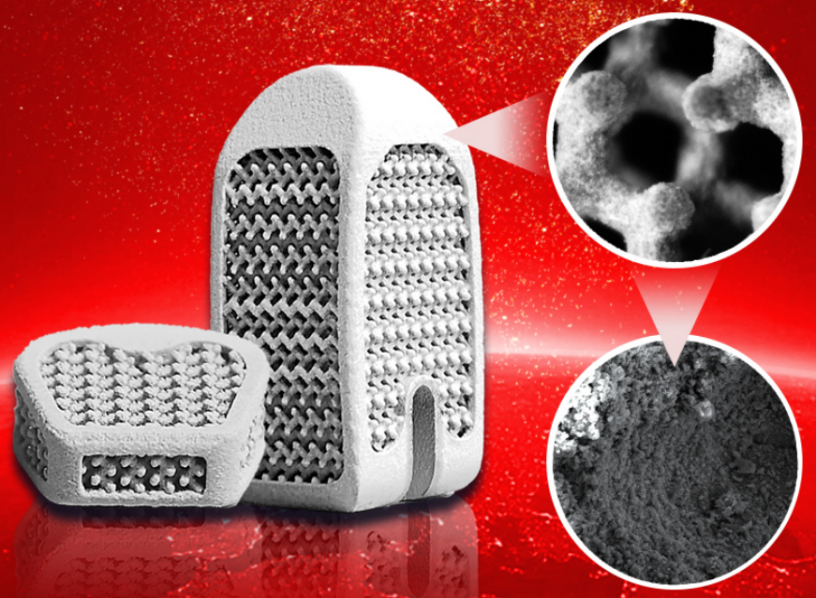Chinese medical firm Wedo Bio-Medical Technology Co, Ltd. has announced that its new 3D printed spinal implant has successfully received market approval in China.
The company’s Hydroxyapatite-Coated Porous Titanium Alloy Interbody Fusion Device, or WedoCage, was 3D printed using technology from Chinese 3D printer manufacturer Bright Laser Technologies (BLT).
The 3D printed WedoCage obtained the Class III Medical Device Registration Certificate from the National Medical Products Administration. This follows the news in May 2023 that Wedo obtained China’s first Class III Medical Device Registration Certificate for its “LPBF-matched Thoracolumbar Artificial Vertebrae.”
According to BLT, these achievements symbolize the broad applications of metal 3D printing in the medical device industry. The company aims to aid in the development of more tailored treatment devices for the repair and reconstruction of complex bone defects in the near future.
“Through metal 3D printing technology, BLT aims to bring benefits to more clinical patients, infusing the field of orthopedic healthcare with greater vitality and possibilities,” the company stated in a press release.
“In the future, BLT will continue to partner with more collaborators in the medical sector, accelerating the development of medical-grade metal materials and innovative products. This effort will empower our customers to provide safer, more precise, adaptable, and efficient solutions for patients.”
 The Hydroxyapatite-Coated Porous Titanium Alloy Interbody Fusion Device developed by Wedo. Image via Bright Laser Technologies.
The Hydroxyapatite-Coated Porous Titanium Alloy Interbody Fusion Device developed by Wedo. Image via Bright Laser Technologies.
New WedoCage spinal implants
Wedo adopted the BLT-S210 and BLT-S310 systems to 3D print the WedoCage, as well as other customized medical devices. These BLT 3D printers are said to enable flexible and rapid 3D printing of personalized orthopedic implants, and the batch production of other standard products.
The WedoCage incorporates a sophisticated and complex porous structure, requiring a high level of precision during 3D printing. Indeed, the spinal implant features extensive overhangs, and demanding product process parameters and support structures.
Manufacturing on Demand
As such, BLT cooperated closely with Wedo’s R&D team to optimize the 3D print parameters of the WedoCage. BLT offered targeted advice regarding 3D printer operation, support strategy, and heat treatment. During the development process, the WedoCage’s porous structure was iterated to meet Wedo’s specific design requirements to ensure stable and reliable product quality.

According to BLT, the WedoCage’s optimized mechanical features and unique Truss + Micro-porous structure allows for low elastic modulus and high fatigue performance. This is said to enable the immediate stability of the fusion implant, allowing for early osseointegration and long-term biological stability.
The WedoCage has already undergone prospective, randomized controlled clinical trials in China. Starting back in 2019, these trials have taken place in over 10 research hospitals. Ultimately, this study found that the fusion effective rate of the WedoCage at six months was 97.10%. This is said to surpass the 85.29% fusion succession rate of PEEK Fusion Devices. Moreover, no product-related adverse reactions were observed during the trial.
“BLT believes that with the support of metal additive manufacturing technology, the application of metal orthopedic implants will continually optimize and enhance the design and performance of medical devices,” the company added. “This will drive ongoing progress and innovation in medical technology, contributing to significant growth and breakthroughs in orthopedic healthcare.”

3D printed medical implants
The development of customizable medical implants is certainly a growing area within additive manufacturing. Earlier this year, it was announced that the first US surgery featuring a 3D printed spinal implant made from Evonik‘s VESTAKEEP i4 3DF PEEK filament material had been conducted.
This implant, developed by US-based technology firm Curiteva, is the first-ever 3D printed, fully interconnected PEEK implant of its kind for commercial use. Evonik’s VESTAKEEP i4 3DF PEEK filament biomaterial has been designed specifically for additive manufacturing, and meets the stringent requirements of ASTM F2026.
Elsewhere, 3D printer manufacturer 3D Systems recently developed a patient specific 3D printed cranial implant for a procedure at the University Hospital Basel in Switzerland. This is the first cranial implant 3D printed at the point of care that complies with current Medical Devices Regulations (MDR). According to 3D systems, the market for cranial implants is expected to reach $2.1 billion by 2030.
“The successful implantation at the University Hospital of Basel is a pivotal moment for medical 3D printing, demonstrating its potential to revolutionize patient care,” commented Prof. Florian Thieringer, Head of Medical Additive Manufacturing Research Group (Swiss MAM) at the hospital’s Department of Biomedical Engineering.
You might also like:
Materialise plays a crucial role in breakthrough eye transplant surgery at NYU Langone Health: On May 27, a surgery took place at NYU Langone Health Hospital in New York, showcasing advancements in reconstructive procedures. A distinctive element of this surgical event was the incorporation of 3D technologies in the medical field. The collaboration involved Materialise, and Depuy Synthes, the Orthopedics Company of Johnson & Johnson, collectively utilizing advanced technology for presurgical planning and the actual procedure. This integration played a pivotal role in enhancing the surgical process.
* This article is reprinted from 3D Printing Industry. If you are involved in infringement, please contact us to delete it.
Author: Alex Tyrer-Jones

Leave A Comment